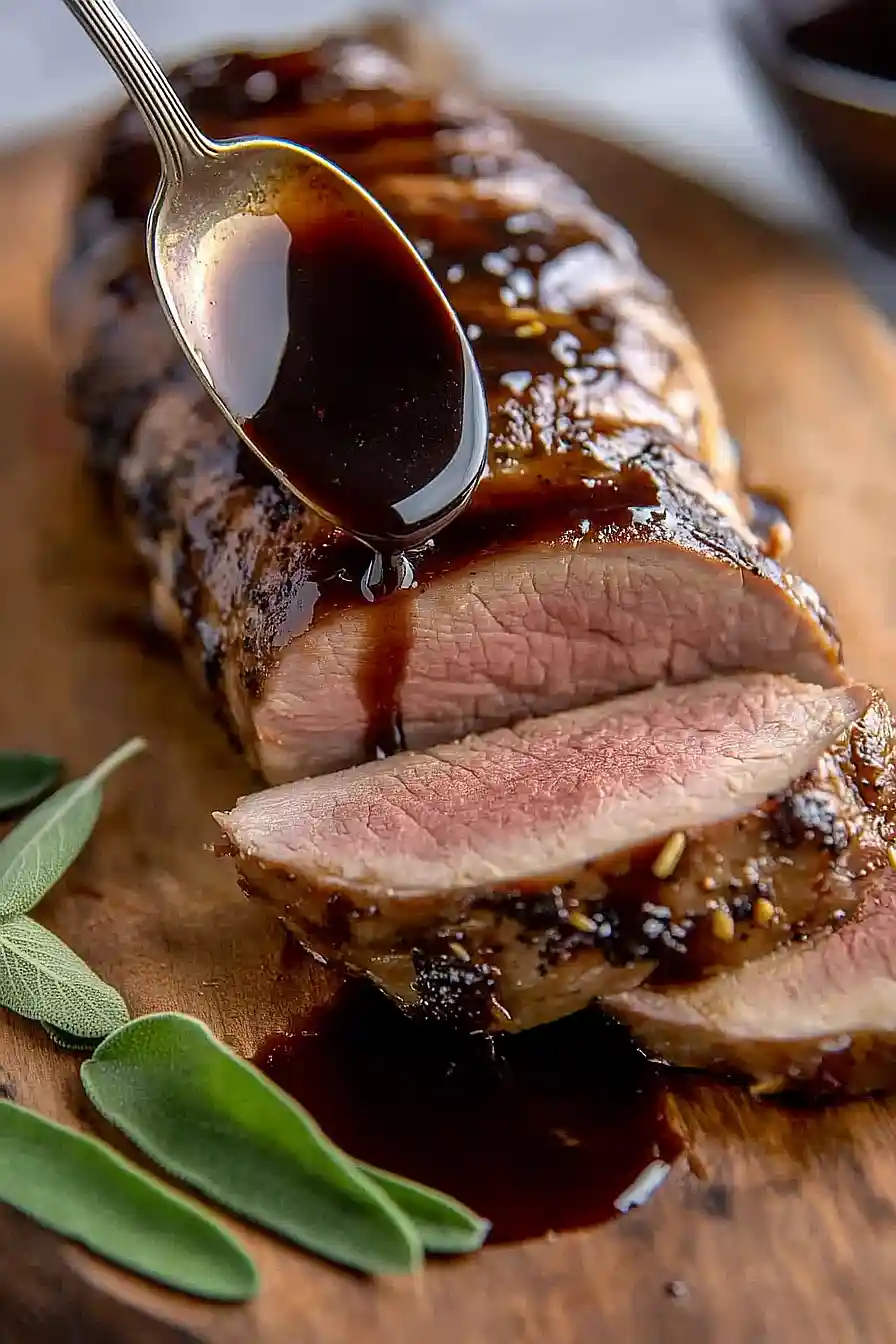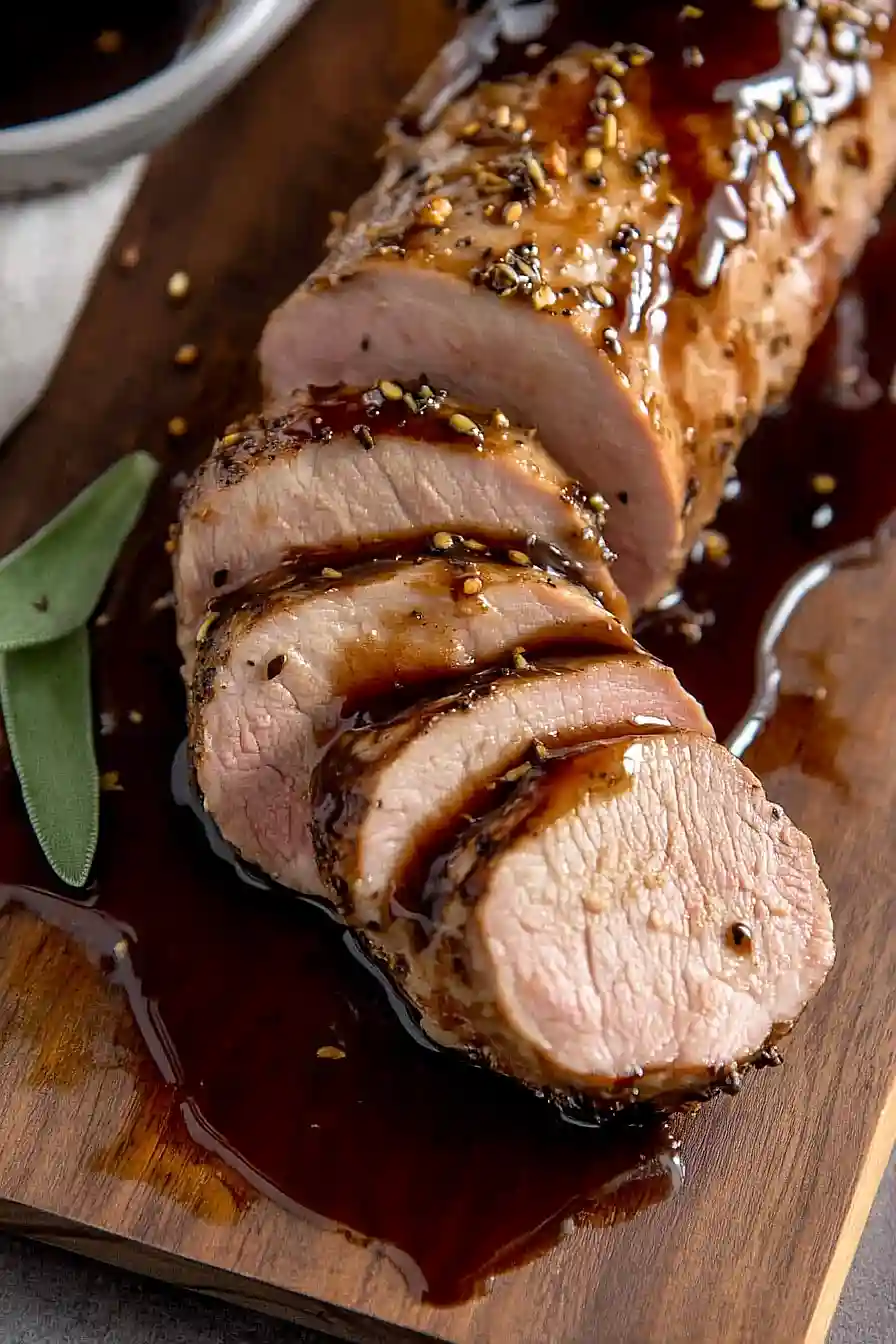Disclaimer: Our editors have used AI to create or enhance parts of this article. All content has been fact-checked by our team to ensure accuracy.
If you ask me, pork tenderloin is one of the most underrated cuts of meat out there.
This balsamic pork tenderloin makes a weeknight dinner that’s packed with sweet and tangy flavors. The meat gets tender and juicy while the balsamic glaze caramelizes into something really special.
It’s seared in a hot pan and finished in the oven with a simple marinade made from balsamic vinegar, garlic, and herbs. Fresh rosemary and a touch of honey help bring all the flavors together.
It’s an easy dish that feels fancy enough for company, perfect when you want something satisfying without too much fuss.

Why You’ll Love This Balsamic Pork Tenderloin
- Quick weeknight dinner – Ready in under an hour, this recipe is perfect for busy evenings when you want something special without spending all night in the kitchen.
- Simple ingredients – You probably already have most of these pantry staples at home, making it easy to whip up without a special grocery trip.
- Sweet and tangy glaze – The balsamic vinegar creates a glossy, flavorful coating that makes ordinary pork tenderloin taste like something from a fancy restaurant.
- Lean and healthy protein – Pork tenderloin is one of the leanest cuts of meat, giving you a satisfying dinner that’s naturally low in fat and high in protein.
- Impressive presentation – This dish looks elegant enough for company but is simple enough for a regular Tuesday night dinner with the family.
What Kind of Pork Tenderloin Should I Use?
When shopping for pork tenderloin, you’ll typically find them packaged in pairs weighing about 1 to 1.5 pounds each, which is perfect for this recipe. Look for tenderloins that are pale pink in color with minimal marbling and avoid any that look gray or have an off smell. Fresh is always best, but frozen pork tenderloin works just fine too – just make sure to thaw it completely in the refrigerator before cooking. Some packages come with the silverskin (that thin, shiny membrane) already removed, but if yours still has it, you’ll want to trim it off with a sharp knife since it can make the meat tough when cooked.

Options for Substitutions
This recipe is pretty forgiving when it comes to swaps, so here are some options if you need to make changes:
- Pork tenderloin: Don’t substitute this one! Pork tenderloin is lean and cooks quickly, which is key for this recipe. Other cuts like pork chops or loin would need different cooking times and methods.
- Dried rubbed sage: If you don’t have sage, try dried thyme or rosemary instead. Fresh sage works too – use about 1 tablespoon of chopped fresh sage in place of the dried.
- Balsamic vinegar: Regular balsamic works fine, but if you only have white wine vinegar or apple cider vinegar, add an extra teaspoon of sugar to balance the flavor.
- Soy sauce: Worcestershire sauce makes a good substitute here – use the same amount. For a gluten-free option, coconut aminos work well too.
- Cornstarch: You can use flour instead, but mix 2 tablespoons of flour with the water rather than 1 tablespoon of cornstarch. The sauce will be slightly less glossy but still tasty.
- Granulated sugar: Brown sugar or honey work as substitutes – if using honey, reduce it to 3 tablespoons since it’s sweeter than granulated sugar.
Watch Out for These Mistakes While Cooking
The biggest mistake when cooking pork tenderloin is overcooking it, which turns this naturally tender cut into a dry, tough disappointment – aim for an internal temperature of 145°F and let it rest for 5 minutes to reach the perfect doneness.
Don’t skip searing the tenderloin first before finishing in the oven, as this step creates a nice crust that locks in juices and adds flavor to your final dish.
When making the balsamic glaze, keep a close eye on it since the sugar can burn quickly – whisk the cornstarch with the water first to prevent lumps, and remove the glaze from heat as soon as it thickens to your liking.
Finally, always let your pork rest for at least 5-10 minutes after cooking before slicing, which allows the juices to redistribute and keeps each slice moist and flavorful.

What to Serve With Balsamic Pork Tenderloin?
This tender, flavorful pork pairs beautifully with roasted vegetables like Brussels sprouts, carrots, or asparagus that can soak up some of that sweet balsamic glaze. I love serving it alongside creamy mashed potatoes or garlic mashed cauliflower to balance out the tangy flavors, and the potatoes are perfect for soaking up any extra sauce. A simple side salad with mixed greens and a light vinaigrette keeps things fresh, or you could go with roasted sweet potatoes for a slightly sweet contrast to the savory pork. Rice pilaf or wild rice also work great if you want something that won’t compete with the balsamic flavors but will help round out the meal.
Storage Instructions
Refrigerate: Leftover balsamic pork tenderloin keeps really well in the fridge for up to 4 days when stored in an airtight container. I like to slice it up and store it with any extra glaze on the side. It makes great leftovers for quick lunches or dinner the next day!
Freeze: You can freeze cooked pork tenderloin for up to 3 months in freezer-safe bags or containers. I recommend slicing it first and freezing the glaze separately in ice cube trays for easy portioning. This way you can thaw just what you need for a meal.
Warm Up: To enjoy your leftover pork, gently warm slices in a skillet over medium-low heat with a splash of water or broth to keep it moist. You can also reheat it in the microwave on 50% power, checking every 30 seconds. Don’t overcook it or the meat will get tough and dry.
| Preparation Time | 10-15 minutes |
| Cooking Time | 30-40 minutes |
| Total Time | 40-55 minutes |
| Level of Difficulty | Medium |
Estimated Nutrition
Estimated nutrition for the whole recipe (without optional ingredients):
- Calories: 1200-1400
- Protein: 150-170 g
- Fat: 70-80 g
- Carbohydrates: 30-40 g
Ingredients
For the pork:
- 2 to 2 1/2 lb pork tenderloin (two tenderloins, each over 1 lb)
- 1 tbsp crushed garlic
- 1 tbsp extra-virgin olive oil
- 1 tbsp dried sage
- 1/2 tsp salt
- 1/2 tsp ground black pepper
For the balsamic glaze:
- 1/4 cup white sugar
- 1/4 cup balsamic vinegar
- 2 tbsp reduced-sodium soy sauce or tamari
- 1 tbsp cornstarch
- 1/4 cup water
Step 1: Prepare Pork Tenderloins and Seasoning Rub
- 2 to 2 1/2 lb pork tenderloin (two tenderloins, each over 1 lb)
- 1 tbsp crushed garlic
- 1 tbsp extra-virgin olive oil
- 1 tbsp dried sage
- 1/2 tsp salt
- 1/2 tsp ground black pepper
Preheat your oven to 375°F (190°C).
Line a 13- x 9-inch pan with heavy-duty foil and place the two pork tenderloins in the pan.
In a small bowl, combine the crushed garlic, extra-virgin olive oil, dried sage, salt, and ground black pepper to form a paste.
Rub this mixture all over both pork tenderloins, making sure they are evenly coated for maximum flavor.
Step 2: Start Baking the Pork
Place the seasoned pork tenderloins (from Step 1) into the preheated oven and bake for 15 minutes.
This starts the cooking process and gives the rub time to permeate the meat.
Step 3: Make the Balsamic Soy Glaze
- 1/4 cup white sugar
- 1/4 cup balsamic vinegar
- 2 tbsp reduced-sodium soy sauce or tamari
- 1 tbsp cornstarch
- 1/4 cup water
While the pork is baking, combine the white sugar, balsamic vinegar, and soy sauce or tamari in a small saucepan over medium-low heat.
In a separate small bowl, mix the cornstarch and water together to make a slurry.
Add the slurry to the saucepan, stirring occasionally.
Heat the mixture until it begins to bubble and thickens slightly to form a shiny glaze.
I like to let the glaze reduce gently to deepen the flavor.
Step 4: Glaze and Finish Roasting the Pork
- glaze from Step 3
- seasoned pork tenderloins from Step 2
After the pork has roasted for the initial 15 minutes, remove it briefly from the oven and spoon a small amount of the warm glaze (from Step 3) over each tenderloin.
Return the pork to the oven and continue baking for an additional 15 minutes, or until the internal temperature of the thickest tenderloin reaches 145°F to 150°F (63°C to 66°C).
Once done, remove the pan from the oven, tent it loosely with foil, and let the pork rest for 5 minutes to retain its juices.
I always let the meat rest before slicing—it makes a big difference in juiciness.
Step 5: Slice and Finish with Glaze
- cooked and rested pork tenderloins from Step 4
- remaining glaze from Step 4
Slice each rested pork tenderloin into 1-inch medallions and return them to the foil-lined pan with the pan juices.
Warm the remaining glaze gently over low heat and pour it over the sliced pork medallions.
Serve immediately while hot for the best flavor and texture.

